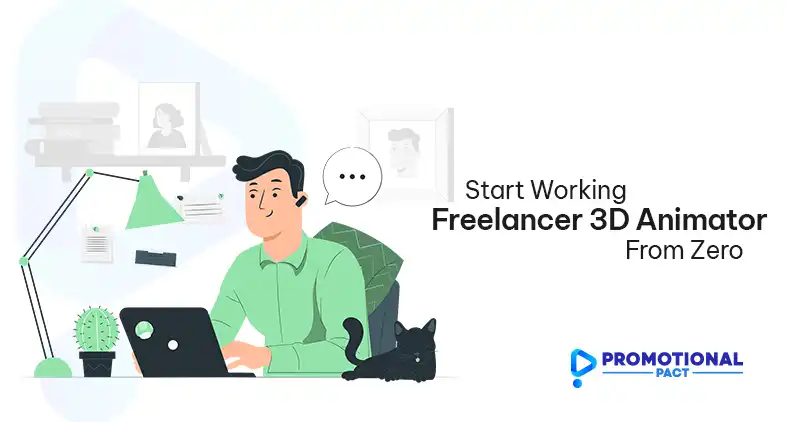The global 3D animation market was valued at around $19 billion in 2022 and is projected to reach over $45 billion by 2030, indicating strong industry growth and demand for 3D animators
Starting a career as a freelance 3D animator can be an exciting yet challenging path. With the right technical skills, business knowledge, and persistence, it’s possible to build a fulfilling and financially rewarding career. I will cover the complete process of going from zero experience to working as a professional freelance 3D animation artist in this article.

1. Start with Learning the Fundamentals of 3D Animation

It can take 2-5 years of dedicated practice to become proficient enough in 3D animation skills to start animating professionally
To start working as a 3D animator, you need a strong foundation in the core skills and software tools used in the industry. Setting aside time to study the fundamentals will pay off tremendously when you start taking on client work.
Software – Learn a 3D Animation Program
The first step is to choose and learn a professional 3D animation program. Some of the popular options include:
- Autodesk Maya
- Blender
- Cinema 4D
- Daz 3D, etc.
You need to become deeply familiar with the interface, navigation, tools, and unique workflows of your chosen software. Spending several weeks or months mastering one program is better than jumping between different apps as a beginner. Some key aspects to focus on include:
- Understanding the production pipeline from modeling to rendering.
- Mastering the modeling, rigging, and animation toolsets.
- Learning keyboard shortcuts to improve workflow speed.
- Following beginner tutorials to grasp the foundations before tackling more advanced techniques.
Modeling – Create 3D Models

3D Modeling by Autodesk
Modeling is the process of creating the 3D objects and characters that will be animated. As an animator, you need a strong foundation in modeling techniques like:
- Polygon modeling to create organic and hard surface models.
- Proper topology to create efficient edge flow for animation.
- Unwrapping and UV mapping for texturing.
- Studying real-world anatomy and form.
Dedicate time to studying modeling principles while creating a variety of 3D models to build your skills. Assemble a library of models to use in your demo reel.
Rigging – Rig Models for Animation

Rigging in Maya
Rigging involves building a digital skeleton for models using joints, bones, and controls. A well-rigged character makes the later animation process much easier. Important rigging skills include:
- Building joint skeletons with proper hierarchy and structure.
- Using controls and constraints to pose the model.
- Applying deformers like skinning to move mesh vertices.
- Rigging faces for facial animation.
Practice rigging a variety of characters to give them natural, easy-to-animate controls. Test your rigs thoroughly to catch any issues before animating.
Animation – Master Principles and Techniques

Master the 12 Principles of Animation – PluralSight
Animation brings models to life through movement over time. Mastering principles like staging, timing, arcs, and secondary motion is key. Important skills include:
- Layout – Block out key poses and actions.
- Keyframing – Set pivotal keyframes to define the motion.
- Curves – Refine transitions between keys for fluidity.
- Weight and force – Add drag, overlap, and follow through.
Study walk cycles, facial animation, and physics. Animate basic motions first before tackling complex scenes. Aim to imbue your animations with weight, emotion, and compelling action.
Lighting – Light the Shot

Master Lighting – DreamFarmStudio
Proper lighting can make or break a 3D scene. Master lighting basics like:
- Three-point lighting – Key, fill, and rim lights.
- Ambient and local lights – Set mood and guide the eye.
- Soft and hard shadows – Define shapes.
- Renderer-specific lights – Learn unique lights like V-Ray or Redshift.
Light characters and environments to focus on silhouettes, enhance drama, and set the mood. Study photography and cinematography principles.
Rendering – Output and Deliver Animations

Introduction to Rendering by Blender
Rendering outputs your animated shot as a video or image sequence. Learn critical skills like:
- Optimizing scene assets and settings for efficient rendering.
- Using render layers for compositing and effects.
- Outputting in suitable formats for different uses.
- Troubleshooting common rendering errors and noise issues.
The rendering process of pulling everything together is crucial to delivering polished animations to clients.
2. Build a Reel & Portfolio

Having a diverse and high-quality demo reel showcasing your animation skills is critical for attracting new clients. Aim for 1-2 minutes displaying your best work.
To start attracting clients, you need a strong demo reel and online portfolio to showcase your skills.
Create a Demo Reel
A demo reel is a 1-2 minute montage featuring your best animation work. Focus on including 3-5 high-quality shots over many mediocre ones. Polish small details on your best models, rigs and animations to feature in your reel.
Build an Online Portfolio
Your portfolio website is a hub to showcase your work and capabilities. Include:
- Demo reel prominently featured.
- Additional galleries of model, texture, and animation work.
- Process samples from projects.
- About page introducing yourself and services.
- Contact page with email, and social media links.
A clean, easy-to-navigate portfolio leaves potential clients impressed by your skills.
- Learn Freelance Business Skills

Being the best animator won’t matter if you’re the worst businessman
Mastering the art skills is only half the battle – you need strong business skills to succeed as a freelancer.
Branding
Create a brand identity for your freelance animation business. This can include having your logo designed professionally, using proper styling like consistent fonts and color branding across platforms, etc.
You should also consider networking with printed cards featuring your logo, contact info, and portfolio link.
Accounting
Handle finances like a professional business. Invoice clients professionally and collect payments on time. Track business expenses for tax deductions. Pay estimated quarterly income taxes.
If things become overwhelming, you can use accounting software to manage invoices and expenses.
Marketing
Actively market your services. Create a LinkedIn profile to connect with clients. Post animated content on Instagram and TikTok. Attend industry networking events. Optimize your website for discoverability. Also, consider targeted ads to reach potential clients.
- Find Clients

Talk to 100 potential clients to land your first gig
Securing your first clients is a major milestone. Be patient and use these strategies:
Job Boards
Sign up for freelance job boards like Upwork and post a strong profile showcasing your reel, portfolio, client testimonials if you have any, and your hourly rate. Only bid on projects that match your skills. Complete your first jobs professionally to build your profile.
Social Media
Promote your business on platforms like LinkedIn, Twitter and Instagram. Connect with potential clients by sharing your best work. Offer helpful tips for aspiring animators to establish yourself as an industry expert.
Networking Events
Look for both in-person and virtual networking events related to 3D animation. Prepare an elevator pitch introducing yourself and your services. Collect business cards and follow up with potential clients after events.
Referrals
Referrals can become a major source of work. Deliver great work on your first gigs, then politely ask happy clients to recommend you for future projects. A portfolio with impressive client logos helps attract more prestigious work.
- Manage Client Projects

Underpromise and overdeliver to impress clients
Once you start signing clients, proper project management ensures a smooth process:
Agree on Project Scope
Carefully define project requirements, deliverables, timeline and payment schedule in a written contract before starting work. Get client sign-off to avoid any misaligned expectations.
Check-in Regularly
Schedule regular check-ins as you work to get client feedback early and often. Surface any issues quickly and adjust course. Frequent communication avoids major problems down the road.
Deliver Work Professionally
Wrap up projects by delivering finished work per the agreed contract terms. Render animations in suitable resolution and formats for the client’s intended use.
Continue Growing Your Skills
As a freelance 3D animator, the learning never stops. Here are tips for ongoing growth:
- Challenge yourself with new animation techniques and styles.
- Stay up to date with the latest software updates and industry trends.
- Connect with other freelancers online to exchange knowledge.
- Consider taking annual workshops or online classes.
- Expand your toolkit by learning new software and skills.
By combining a comprehensive 3D animation skillset with smart business practices, you can build a thriving freelance career doing what you love. With determination and consistency, you can go from zero experience to taking on paid client work and establishing yourself as a professional 3D animator.
Frequently Asked Questions
How long does it take to learn 3D animation?
It typically takes 1-2 years of consistent practice to gain proficiency with 3D animation fundamentals. Building a client-ready demo reel often requires 2+ years. Be patient and focus on continual learning.
What computer do I need for 3D animation?
You’ll need a sufficiently powerful Windows or Mac workstation. Prioritize CPU, RAM, GPU power, and plenty of storage. Many animators use desktops with dedicated gaming graphics cards.
What is the average salary for a freelance animator?
Salaries vary based on location, skills, and experience level. Beginners may charge $15 – $50 per hour, while senior animators can charge $75 – $150 per hour. With time, six-figure incomes are possible.
How do I get my first animation clients?
Leverage job boards, social media, and networking to land your first gigs. Focus on successfully completing projects for early adopter clients to build your experience, portfolio, and positive referrals.

